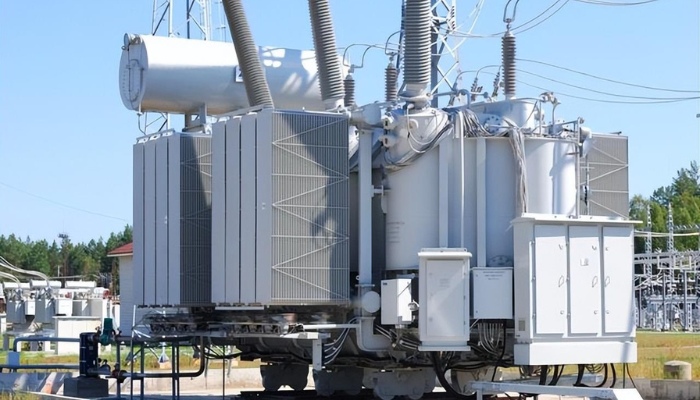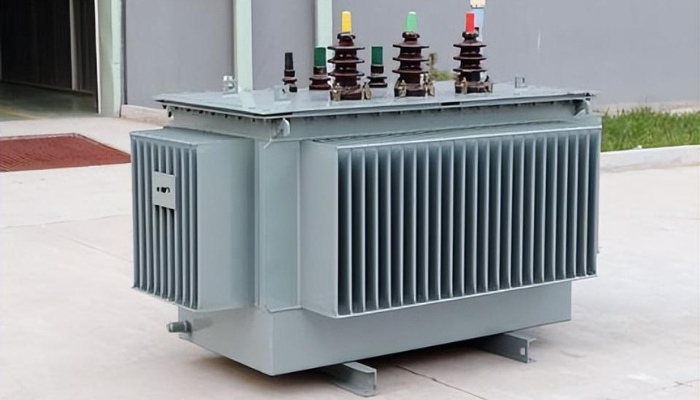In the operation of power transmission and distribution, power & distribution transformers are essential, and it is very necessary to be familiar with and master the basic knowledge of transformers. The basic knowledge reserve of transformers is a necessary skill for every electrical engineer.
1. What is a power transformer?
In an AC circuit, the device that raises or lowers the voltage is called a transformer. The transformer can convert any value of voltage into the voltage value we need with the same frequency to meet the requirements of energy transmission, distribution, and use. For example, the electricity generated by a power plant has a low voltage level, and the voltage must be raised in order to be transmitted to a distant electricity consumption area. The electricity consumption area must be reduced to a suitable voltage level through voltage reduction to supply power equipment and daily electrical equipment.
2. How does a power transformer change voltage?
Transformers are made based on electromagnetic induction. It consists of an iron core stacked with silicon steel sheets (or silicon steel sheets) and two sets of coils wound around the iron core. The iron core and coils are insulated from each other and have no electrical connection, as shown in the figure. We refer to the coil connecting the transformer to the power supply side as the primary coil (or primary side), and the coil connecting the transformer to the electrical equipment as the secondary coil (or secondary side). When the primary coil of a transformer is connected to an AC power source, a changing magnetic field line will be generated in the iron core. Due to the fact that the secondary coil is wound around the same iron core, the magnetic line of force cuts the secondary coil, which inevitably generates an induced electromotive force on the secondary coil, causing voltage to appear at both ends of the coil. Because the magnetic field lines are alternating, the voltage of the secondary coil is also alternating. And the frequency is exactly the same as the power frequency. It has proven that the voltage ratio between the primary and secondary coils of a transformer is related to the ratio of turns between the primary and secondary coils, which can be expressed as follows: primary coil voltage/secondary coil voltage=number of turns in the primary coil/number of turns in the secondary coil, indicating that the more turns there are, the higher the voltage. Therefore, it can be seen that the secondary coil is less than the primary coil, which is a step-down transformer. On the contrary, it is a step-up transformer.
3. What are the types of transformer ?
There are single-phase and three-phase transformers according to the number of phases. It is divided into power transformer, special power transformer, voltage regulating transformer, measuring transformer (Voltage transformer, current transformer), small power transformer (used for small power equipment) and safety transformer according to the purpose. It is divided into core type and shell type according to the structure. The coil has double winding and multi winding, and Autotransformer can be divided into oil immersed type and air cooled type according to the cooling mode.
4. What are the components of a transformer?
The transformer components are mainly composed of iron cores and coils, as well as oil tanks, conservators, insulation sleeves, and tapping heads.
5. What is the use of transformer oil?
The function of transformer oil is: (1) insulation effect. (2) Heat dissipation effect. (3) Eliminate the arc effect.
6. What is a Autotransformer?
The Autotransformer has only one set of coils, and the secondary coil is tapped out from the primary coil. Its electric energy transmission includes not only electromagnetic induction transmission, but also electric transmission. The number of silicon steel sheets and copper wires of this transformer is less than that of ordinary transformers, and it is often used to regulate voltage.
7. How is the Pressure regulator regulated in a transformer
The structure of the Pressure regulator is the same as that of the Autotransformer, except that the iron core is wound on the ring iron core as a ring coil. The secondary coil tap uses a sliding brush contact to make the contact ring slide along the surface of the coil, achieving a smooth voltage regulation effect.
8. What is the current relationship between the primary and secondary coils of a transformer?
When a transformer operates with a load, the change in secondary coil current will cause a corresponding change in primary coil current. According to the principle of magnetic potential balance, the current of the primary and secondary coils is inversely proportional to the number of coil turns. The current on the side with more turns is smaller, and the current on the side with less turns is larger. This can be expressed as follows: primary coil current/secondary coil current=secondary coil turns/primary coil turns.
9. What is the voltage change rate of a transformer?
The voltage change rate of the Pressure regulator is one of the main performance indicators of the transformer. When a transformer supplies power to a load, the voltage at the load end of the transformer will inevitably decrease. Compare the decreased voltage value with the rated voltage value, and take the percentage as the voltage change rate, which can be expressed by a formula; Voltage change rate=[(secondary rated voltage – load terminal voltage)/secondary rated voltage] × 100%. A typical power transformer has a voltage change rate of 4-6% when connected to the rated load.
10. How to ensure that the transformer has a rated voltage output?
If the voltage is too high or too low, it will affect the normal operation and service life of the transformer, so it is necessary to adjust the voltage. The method of voltage regulation is to introduce several taps into the primary coil and connect them to the tap opening. The tap opening changes the number of turns of the coil by rotating the contact. Just rotate the position of the tap changer to obtain the required rated voltage value. It should be noted that voltage regulation should usually be carried out after cutting off the load connected to the transformer.
11. What are the commonly used small transformers? What are the applications in?
Small transformers refer to single-phase transformers with a capacity of less than 1 kVA, mostly used as power transformers for electrical equipment control, electronic equipment power transformers, and safety lighting power transformers.
12. What are the losses of transformers during operation? How to reduce losses?
The losses during transformer operation include two parts; (1) It is caused by the iron core. When the coil is energized, the magnetic field lines are alternating, causing eddy current and hysteresis losses in the iron core. This loss is collectively referred to as iron loss. (2) It is caused by the resistance of the coil itself. When there is current passing through the primary and secondary coils of the transformer, electrical energy loss occurs, which is called copper loss.
The sum of iron loss and copper loss is transformer loss, which is related to transformer capacity, voltage, and equipment utilization. Therefore, when selecting transformers, it is important to ensure that the equipment capacity is consistent with the actual usage, in order to improve equipment utilization, and be careful not to operate the transformer under light load.
13. What is the nameplate of a transformer? What are the main technical data on the nameplate?
The nameplate of the transformer indicates the performance, technical specifications, and usage situation of the transformer, which is used to meet the user’s selection needs. The main technical data that should be paid attention to during selection are:
(1) KVA of Nameplate capacity. The output capacity of the transformer under rated state. For example, Nameplate capacity of single-phase transformer=U line × Line I; Three phase transformer capacity=U line × Line I.
(2) Rated voltage in volts. Indicate the terminal voltage of the primary coil and the terminal voltage of the secondary coil (when not connected to the load) separately. Note that the terminal voltage of the three-phase transformer refers to the line voltage U line value.
(3) Rated current in amperes. It refers to the line current I line value that the primary coil and secondary coil are allowed to pass for a long time under the conditions of Nameplate capacity and allowable temperature rise.
(4) Voltage ratio. The ratio of the rated voltage of the primary coil to the rated voltage of the secondary coil.
(5) Wiring method. Single-phase transformers only have one set of coils for high and low voltage, and are only supplied for single-phase use. Three-phase transformers have Y/△ types. In addition to the above technical data, there are also the rated frequency, number of phases, temperature rise, and impedance percentage of the transformer.
14. How to choose a transformer? How to determine the reasonable capacity of a transformer?
Firstly, it is necessary to investigate the power supply voltage in the electricity consumption area, the actual electricity load of the user, and the conditions of the location. Then, reference should be made to the technical data indicated on the transformer nameplate to select one by one. Generally, the transformer capacity, voltage, current, and environmental conditions should be comprehensively considered, and the capacity selection should be based on the capacity, nature, and usage time of the user’s electrical equipment to determine the required load, in order to select the transformer capacity.
During normal operation, the power load borne by the transformer shall be about 75~90% of the Nameplate capacity of the transformer. When the actual bearing load of the transformer is measured to be 50% less than% during operation, the small capacity transformer shall be replaced. If it is greater than the Nameplate capacity of the transformer, the large transformer shall be replaced immediately. At the same time, when selecting a transformer, the voltage value of the primary coil of the transformer is determined based on the line power supply, and the voltage value of the secondary coil is selected based on the electrical equipment. It is best to choose a low-voltage three-phase four-wire power supply. This can provide both power and lighting electricity simultaneously.
For the selection of current, it is important to pay attention to whether the load can meet the requirements of the motor when starting (because the starting current of the motor is 4-7 times greater than when running in sinking mode).
15. Why cannot transformers operate under overload?
Overload operation refers to the operation of a transformer exceeding the current value specified on the nameplate. Overload is divided into two types: normal overload and accident overload. The former refers to the increase in user electricity consumption under normal power supply conditions, which often leads to an increase in transformer temperature, aging of transformer insulation, and reduced service life. Therefore, transformer overload operation is not allowed. Under special circumstances, the overload operation of the transformer in a short period of time cannot exceed 30% of the rated load (in winter), and cannot exceed 15% in summer.
16. What types of tests should transformers undergo during operation?
In order to ensure the normal operation of the transformer, the following tests should be conducted frequently:
(1) Temperature testing. Whether the operation status of the transformer is normal or not depends on the temperature level. The regulations stipulate that the upper oil temperature shall not exceed 85C (i.e. temperature rise of 55C). Generally, transformers are equipped with dedicated temperature measurement devices.
(2) Load measurement. In order to improve the utilization rate of transformers and reduce the loss of electrical energy, it is necessary to measure the actual power supply capacity that the transformer can bear during operation. The measurement is usually carried out during the peak period of electricity consumption in each season, and is directly measured with a clamp Ammeter. The current value should be 70-80% of the rated current of the transformer. If it exceeds the limit, it indicates overload and should be adjusted immediately.
(3) Voltage measurement. The regulation requires that the voltage variation range should be within ± 5% of the rated voltage. If it exceeds this range, a tap should be used to adjust the voltage to reach the specified range. Generally, Voltmeter is used to measure the terminal voltage of the secondary coil and the terminal voltage of the end user.
(4) Insulation resistance measurement. In order to keep the transformer in normal operation, it is necessary to measure the insulation resistance to prevent insulation aging and accidents. When measuring, efforts should be made to stop the transformer from running, and the insulation resistance value of the transformer should be measured using a megger. The measured resistance should not be less than 70% of the previous measured value. When using a megger, the low-voltage coil can use a voltage level of 500 volts.
PowerTel & his associated factories having over 50 years manufacturing experience, we can provide you a wide range of power transformer, up to 500 kV and a full range of distribution transformer for your various applications. and a custom design & fabrication is always available on your exact technical requirement.
Please feel free to contact us. 
